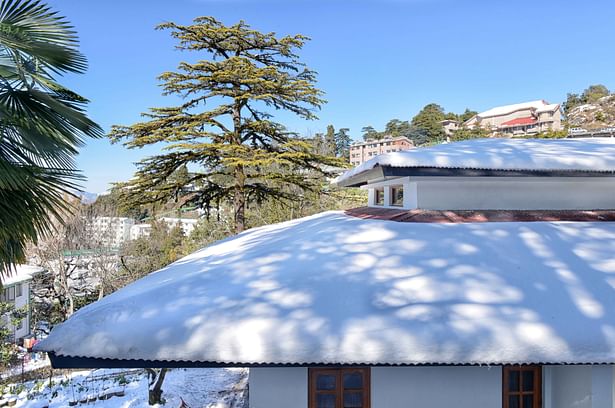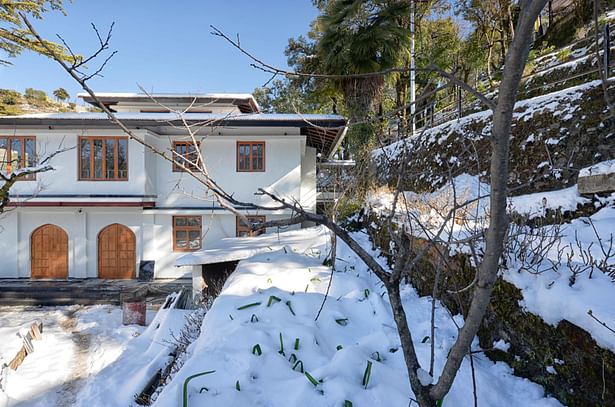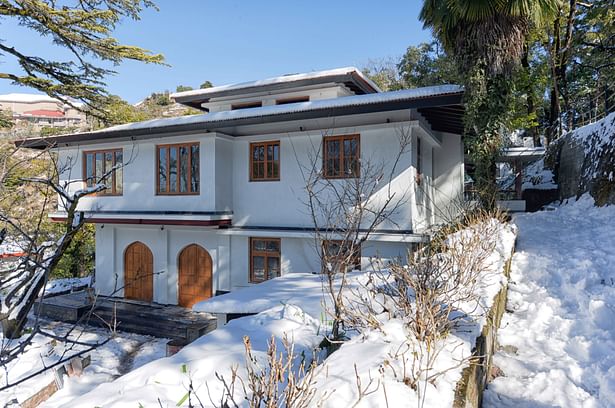

Architect: Ranjeet Mukherjee
Interior Designer: Shreenu Mukherjee
Design Firm’s Name: The Vrindavan Project
Phone Number: +91 9560107193
Email: ranjeet.mukherjee@gmail.com / thevrindavanproject@gmail.com
Instagram: @ranjeetmukherjee @shreenu.mukherjee @monikasathephotography
Facebook: https://www.facebook.com/The.Vrindavan.Project/
Google: https://g.page/The-Vrindavan-Project?gm
Photographer: https://www.monikasathe.com/
Project Name: Holmwood Transfiguration
Project Location: Mussoorie, Uttarakhand, India
Project Type: Private, Residential, Ancestral, Colonial Era, Heritage Bungalow
Context: Mountain, Hill-Station, Contour, Terraced, Sloping Site
Building’s Age: 150 Years +
Built-up Area: 5000 sq.ft
Commencement: March 2016
Completion: March 2020
Materials: Recycled Wooden Doors, Windows, Roof Elements, RCC Internal Disaster Resistant Foundation Tie Beams RCC External Foundation to Counter Sinking Plinth Tie Band RCC Embedded North Column Pins, Supporting Cantilever Beam Steel Retrofitted Stone / Brick / Adobe Masonry Existing Walls M.S. Welded Flats, Angle Grid as Ground Floor Exoskeleton Steel Girders Supporting Kota Stone Composite Slab M.S. Box Section Rafter / Wooden Soffit Metal Sheet Pitched Roof Natural Seasoned Wooden Flooring Staircase Surface, Metal Body Natural, Local Stone Flooring, Counters and Wall Tiles
Construction: Ecological, Green, Sustainable, Local, Low Impact, Sensitive, Hand-Made, Hand-Crafted, Artisan, Craft, Craftsman, Craftsperson Traditional, Technology, Techniques, Masonry, Workmanship, Detail
Keywords: #Transfiguration, #Conservation, #Retrofit, #Restoration, #Renovation, #Recycle, #Reinforcement, #Repair, #Renewal, #Reuse, #Transformation
This project truly taught us what the ‘rigor’ of sincere Architectural praxis entails. Spanning a four-year long design and construction process, we were always acutely aware of how insignificant, the time and effort taken towards conservation actually was; when compared to the age and majesty of this ‘grand old lady’ of a house. It is said that this was the second structure built during the inception of ‘Mussoorie’ as a hill station by the British Empire. Understanding that we were merely participants, in the complex and layered evolution of this structural form for over a century, was key.
Setting our own design aspirations aside, we listened to the home. We studied the large joint family occupying this home (as a summer vacation retreat), in thorough detail so to strategize an appropriate design response. Integrating modern systems, services and amenities with a built form that was planned… before electricity and piped water was even available at the location, was quite a challenge. Utility detailing paled in comparison to the herculean engineering efforts put into reinforcing and seismically retrofitting this house, so as to withstand future disaster scenarios.
Foundations of the building were sinking at the North Western corner, owing to settling terraced contours of the site itself; as the hillside geologically shifted over time. Our client was particularly emotional about this property as it was his deceased mother’s favorite living space and place of retirement. Therefore, he was very specific in his desire to retain as much of the original structure’s actual materials as physically possible. Conservation, preservation, recycling and repair of everything on site was the given directive, in addition to all the varied modernization and expansion requests.
Upon inspecting the structure, we determined that a gabion wall metal grid system would have to be created, forming an exoskeleton of all ground floor walls. This gabion grid welded together using steel flat and angle sections while bound by a wire mesh, was set in place to compensate for crumbling walls, by treating their mixed material’s mass, as filling volume for this metal exoskeleton. Tie beams and an external retaining RCC plinth band were surgically inserted into trenches dug around foundations, to strengthen settling foundations and serve as a loading base plate support for the gabion grid system.
The original intermediate floor slab was predominantly constructed using wooden rafters, supporting planks covered by a mud floor, which was thereafter sealed with a thin cement plaster lining as a base for extensive indoor carpeting. Naturally with seepage and humidity, most of this material had deteriorated over time and was even caving in at places. In keeping with the original structural rhythm of the building’s original design, we replaced these old wooden rafters with steel girders supporting spanning stone slabs as a visible ceiling soffit from below. This girder and natural stone composite served as lost shuttering; for a minimal thickness, binding reinforced concrete slab which cantilevers northwards by over three feet, to provide extra space for first floor rooms above.
A mezzanine floor stemming from a double height cut-out above the ground floor living room, reveals steel metal section rafters of the two top roof levels. These roof rafters follow the same structural rhythm interval of the intermediate floor’s steel girders supporting stone, for continuity. For the pitched roof, a pine wood thin soffit board provides a warm natural glow to all spaces below. The roof top layer is made of the same corrugated metal sheet that was originally used in the house. Thermal insulation is provided between the roof top surface and wooden soffit below, with an extra aluminum sheeting base layer as waterproofing protection.
Status: Built
Location: Mussoorie, IN
Firm Role: Architect and Interior Designer
Additional Credits: Monika Sathe Photography




